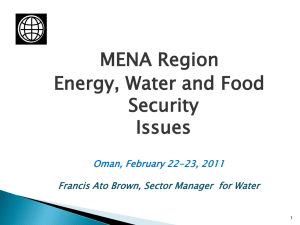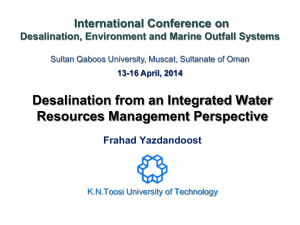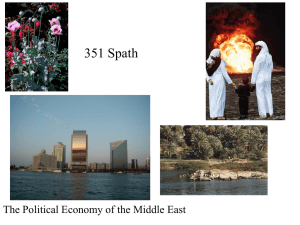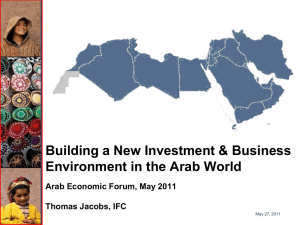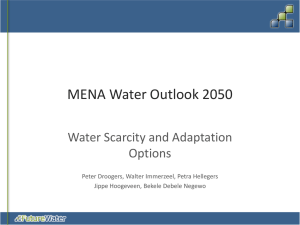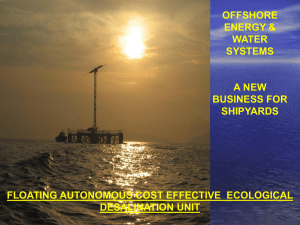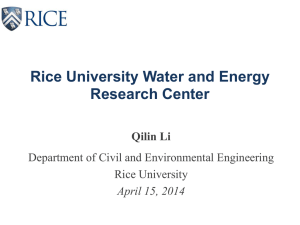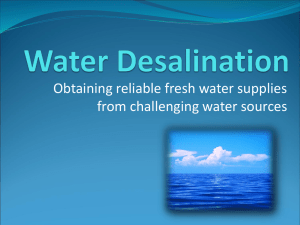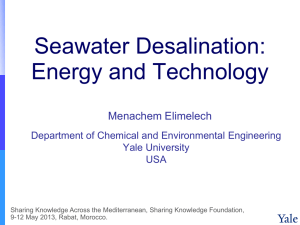Energy, Water and Food Security Nexus: The Scope of Desalination
advertisement
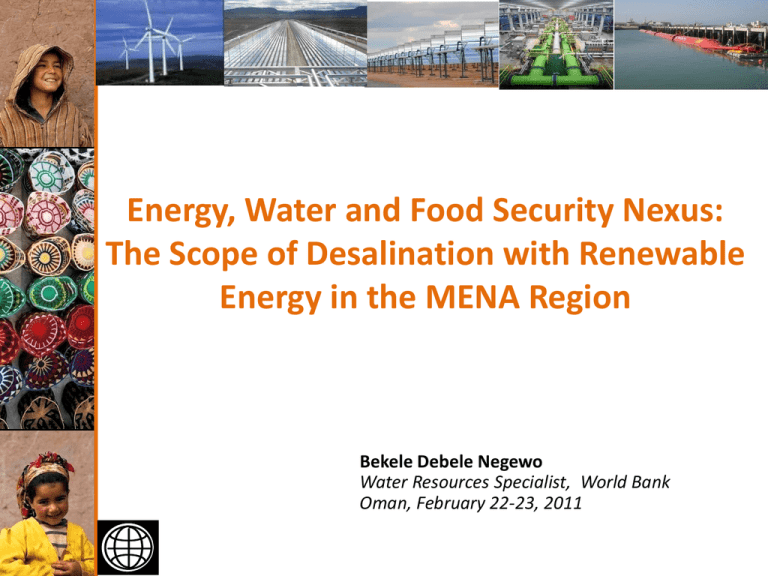
Energy, Water and Food Security Nexus: The Scope of Desalination with Renewable Energy in the MENA Region Bekele Debele Negewo Water Resources Specialist, World Bank Oman, February 22-23, 2011 1 of 40 Outline Overview of the challenges What is the World Bank doing? MENA Regional desal and RE Nexus Next steps 2 of 40 MENA has the lowest per capita water resources worldwide…it’s dwindling fast! Australia & New Zealand Latin America & Caribbean North America Europe & Central Asia Sub-Saharan Africa East Asia & Pacific (incl. Japan&Koreas) Western Europe South Asia Middle East & North Africa 0 10 20 30 40 1000 m^3 / year Annual renewable water resources per capita Source: FAO AQUASTAT (2007) a) Average annual renewable water resources for MENA (2007) was 1,200 m3/capita, compared to 7,000 m3/capita globally.. b) 14 out of the top 20 Water Scarce Countries are in MENA 3 of 40 c) Water scarcity will become a challenge to growth Water scarcity trend in MENA…scary! Cubic meters per capita 4,000 3,000 Renewable water availability per capita… projected to be less than 650 cubic meters per capita per annum by 2050 Since 1950, per-capita renewable water resources have fallen by about 75% 2,000 1,000 0 1950 2000 Source: Adapted from FAO, 2008 4 of 40 2050 …today’s water deficit in MENA is met by overexploitation of groundwater and—to a lesser degree—by fossil-fuelled desalination, but this is not sustainable… 5 of 40 …reality is also that the scarce water is managed and used less efficiently 1. Irrigation consumes 80% of water withdrawn regionwide - Water use efficiency in agriculture is low (< 50%) 2. Losses are also common in water supply systems - Leakages in the network are common (over 10-30%) - High UFW (over 30-40%) 3. Pervasive subsidies in energy and water sectors - Lead to overutilization of the scarce resource - Financially unsustainable systems 6 of 40 Climate change will exacerbate water scarcity The combination of climate change and population growth are projected to reduce available water resources per capita by 50% in 2050. Increasing water scarcity will negatively affect • Economic growth • Public health and quality of life • Food security • Regional stability Implications of climate change in the region include: • Increased temp. and reduced overall precipitation • Reduced average runoff • Increased climate variability (longer dry spells and higher rainfall intensity 7 of 40 What does the future hold…..? WATER: • Water deficit is projected to increase from 50 BCM per year today to 150- to 235 BCM per year by 2050, based on the level of water use efficiency and wastewater reuse adopted, 2/3 times the physical volume of the Nile River flow…scary! ENERGY: • Correspondingly, about 31 billion barrels of fuel is needed to desalinate about 150 BCM of water per year by 2050 (e.g., KSA today uses > 1.5 million bbls/day for desal)…not sustainable Environmental impacts/GHG Emissions: • Which corresponds to 9.6 GtC (gigatonnes of carbon) of CO2 emissions per year by 2050….not sustainable (global good) And food security…? • 60 % of food from irrigated agr. (21 Mha, consuming 251BCM+) • In some areas, fossil groundwater is being exploited for irrigation…not sustainable…rainfed plays a good role but threatened by Climate Change. 8 of 40 Addressing the challenge requires multi-pronged approach 1. Demand side management: a) Strengthen institutions to support a move towards more efficient resource use b) Support policies that rationalize demand for water services c) Support investments in efficiency improvement 2. Supply Augmentation: a) Introduce/scale-up technologies in desalination and reuse b) Support innovations in renewable energy (e.g., CSP) c) Support innovations in concentrate management d) Support water quality protection and storage capacity, including aquifer recharge… 9 of 40 Desalination potential is on the rise in MENA Forecasted Desalination Capacity (2008-2016), 12 MENA countries are in the TOP 20 globally. .. and the trend is projected to continue beyond 2016 with more MENA countries coming into picture, especially Egypt source: GWI (2008) 10 of 40 11 of 40 Rationale for Action…. • Water is scarce in the region, and getting scarcer with time…water will become a challenge to growth…the trend is not sustainable • Desalination on a larger scale has environmental and energy implications (brine, GHG emissions, energy security)…should be sustainable. • Renewable energy (e.g., CSP) is possible, making it a feasible energy alternative…MENA is also suitable for CSP. • Countries in MENA are already leading the innovation and market demand for desal: Some countries use desal water for 100% of their water need MENA countries are on the cutting edge of innovation in the combined use of desal and RE, mainly CSP (e.g., Saudi and IBM) • The region would benefit from cultivating the desert for a growing population and economy, using the natural resources that are barely tapped: desert land, salty water and solar energy, in order to ensure sustainable development…but action has to start soon and on large scale to benefit from economy of scale. 12 of 40 What is the World Bank doing? Contribute to the Strategic Objective: Cultivating the desert for a growing population in MENA, using the natural resources that are barely tapped: desert land, salty water and solar energy ensure sustainable growth. Objectives of the MENA desal and RE nexus study: To gain a better understanding of the issues and options of water supply and demand in the region, the scope for demand and supply side management of water, and the scope for desalination and renewable energy nexus, including concentrate management; To provide more analytical tools to decision makers in the region to evaluate the benefits and costs of the various options to deal with increasing water scarcity, and make informed decisions on the use of desalination, and the use of renewable energy in desalination processes. 13 of 40 What is the World Bank doing? Launched in August/ Sept. 2010 21 countries involved Study: two components: Water availability and demand assessment Desalination and renewable energy, concentrate management 14 of 40 MENA regional desal and RE nexus study I. Water availability and demand assessment, including Implications of climate change on water supply and demand water stress and options to close the gap, with associated costs—marginal cost of additional water II. Desalination and energy, with more focus on RE/ CSP review desalination technology ~ (feed water, energy source, location, etc) review the scope desalination with renewable energy (with a focus of CSP) III. Concentrate management review options to deal with concentrate, with associated cost review of environmental laws and regulations that dictate safe disposal of concentrates IV. Case studies, including assessment of different financing modalities 15 of 40 3-4 case studies looking at: tradeoffs of alternative sources of water, energy, and concentrate management. The case studies will also look at the various alternatives of financing modality. Next steps a) Case studies, what areas should be covered? barriers (policies, technology, financing, environment, etc) b) Where, which countries? c) Financing modality (cost-sharing) 16 of 40
